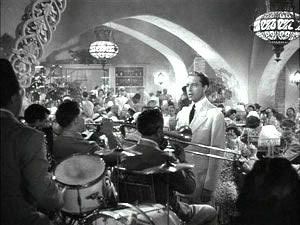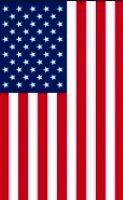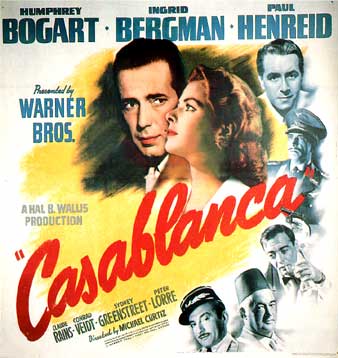
Play the Marseillaise!
 |
 |
 |
| "I am an American fighting man. I serve in the forces which guard my country and our way of life. I am prepared to give my life in their defense." |
Posted on 04/24/2015 5:42:55 PM PDT by DemforBush
Bogey, Bergman and Claude Raines star in this WW2 noir classic. 'Nuff said!
(Excerpt) Read more at youtube.com ...
One of my all-time favorites.
I can recite it for you, if you like.

 |
 |
 |
| "I am an American fighting man. I serve in the forces which guard my country and our way of life. I am prepared to give my life in their defense." |
One of the best movies of all time. Then again, just about anything with Bogart is great.
The Stranger 7/10
Decision Before Dawn 7.5/10
Plunder Road 6.75/10
The Hitchiker 7/10
Stalag 17 8/10
The Killers 8/10
Kiss of Death8/10
D.O.A.7/10
Breaker Morant 8.5/10
Detour 7/10
Stalingrad 7.7/10
Sleuth 8/10
Evil Roy Slade 7/10
Men in War6.75/10
Five Fingers/Operation Cicero 8/10
Escape From Sobibor 7.5/10
Better Off Dead 7/10
A Christmas Carol 8.25/10
The Earthling7.25/10
The Hill8/10
The DI 7/10
Ronald Reagan in Tennessee's Partner 7/10
Duel 7.5/10
Attack! 7.5/10.
Scarlet Street8/10.
This is the Army! 7/10
M8.25/10
Beat The Devil 6.5/10
Kanal7.75/10
Nightmare Alley 7.75/10
And Then There Were None 7.5/10
Zulu 8.5/10
The Final Countdown 7/10
The Maltese Falcon 8/10
Ping!
As always, if you want on or off my ping list, feel free to post a request or FRmail me.
And, again as always, if I forget to add you, feel free to administer a Leroy Jethro Gibbs headsmack to remind me.
LOL. I’ve seen it a million times too.
I read somewhere that no one expected Casablanca to be such a major film. The story was that the stars were approaching the end of their contracts and needed one more movie to fulfill their contracts. Casablanca was just supposed to be that movie.
Sweet!
It was considered a “B” movie.
It was Wonderful.
I saw it for the first time at the Brattle Theater at Harvard University during a Bogie festival back in the 60’s.
I was blown away by it!
That’s right. A B movie. Turned out better than some A movies.
I don’t remember when I first saw it, but I’ve seen it a zillion times. I think Casablanca turned me on to old movies. I really don’t like most of what’s out there these days. They just don’t compare to movies from long ago.
I love old movies.
Hey...here is a cool “Old Movie” story you might appreciate:
When my dad was 16, he worked as an usher in a Boston Theater. He loved the projection room and used to hang out with the projectionist, learning the trade.
One day some special new machines arrived for a film that was in a new format. The film arrived in several huge cans and had twice as many reels as a normal movie. Dad eagerly ran up to the booth to watch the man load up this new film, but the boss was unconscious...drunk. So Dad loaded up the machines the best he could, coordinated the overlapping reels and showed a flawless performance of the Boston Premiere of “Gone With the Wind”.
I guess it’s in my blood.
Great story. Thank you for sharing.
One of the very best, I have the video.
I remember every detail. The Germans wore gray, you eore blue.
First time I saw it was in a theater on the big screen for its 50th anniversary rerelease. The way it was meant to be seen. My wife found out I’d never seen it and she forbid me from watching it all cut up on TV ... We were only dating at the time, so ..
This should be viewed on a big screen, not youtube. It is too good for a tiny screen.
Sounds like the inspiration for “Cinema Paradiso”......
Awesome! Of all the gin joints...
Round up the usual suspects.
Later
 |
|
| Casablanca (1942) | |
Background
 The classic and much-loved romantic melodrama Casablanca (1942), always found on top-ten lists of films, is a masterful tale of two men vying for the same woman's love in a love triangle. The story of political and romantic espionage is set against the backdrop of the wartime conflict between democracy and totalitarianism. [The date given for the film is often either 1942 and 1943. That is because its limited premiere was in 1942, but the film did not play nationally, or in Los Angeles, until 1943.]
The classic and much-loved romantic melodrama Casablanca (1942), always found on top-ten lists of films, is a masterful tale of two men vying for the same woman's love in a love triangle. The story of political and romantic espionage is set against the backdrop of the wartime conflict between democracy and totalitarianism. [The date given for the film is often either 1942 and 1943. That is because its limited premiere was in 1942, but the film did not play nationally, or in Los Angeles, until 1943.]
With rich and smoky atmosphere, anti-Nazi propaganda, Max Steiner's superb musical score, suspense, unforgettable characters (supposedly 34 nationalities are included in its cast) and memorable lines of dialogue (e.g., "Here's lookin' at you, kid," and the inaccurately-quoted "Play it again, Sam"), it is one of the most popular, magical (and flawless) films of all time - focused on the themes of lost love, honor and duty, self-sacrifice and romance within a chaotic world.
Woody Allen's Play It Again, Sam (1972) paid reverential homage to the film, as have the lesser films Cabo Blanco (1981) and Barb Wire (1996), and the animated Bugs Bunny short Carrotblanca (1995). The line "Play it again, Sam" appeared in the Marx Brothers' A Night in Casablanca (1946). Clips or references to the film have been used in Play It Again, Sam (1972), Brazil (1985), My Stepmother is an Alien (1988), and When Harry Met Sally (1989).
Directed by the talented Hungarian-accented Michael Curtiz and shot almost entirely on studio sets, the film moves quickly through a surprisingly tightly constructed plot, even though the script was written from day to day as the filming progressed and no one knew how the film would end - who would use the two exit visas? [Would Ilsa, Rick's lover from a past romance in Paris, depart with him or leave with her husband Victor, the leader of the underground resistance movement?] And three weeks after shooting ended, producer Hal Wallis contributed the film's famous final line - delivered on a fog-shrouded runway.
The sentimental love story, originally structured as a one-set play, was based on an unproduced play entitled Everybody Comes to Rick's by Murray Burnett and Joan Alison - the film's original title. Its collaborative screenplay was mainly the result of the efforts of Julius J. and Philip G. Epstein and Howard Koch. In all, six writers took the play's script, and with the models of Algiers (1938) and Only Angels Have Wings (1939) to follow, they transformed the romantic tale into this quintessential classic that samples almost every film genre.
Except for the initial airport sequence, the entire studio-oriented film was shot in a Warner Bros. Hollywood/Burbank studio. Many other 40s stars were considered for the lead roles: Hedy Lamarr, "Oomph Girl" Ann Sheridan, French actress Michele Morgan, and George Raft.
[It's an 'urban legend' that Ronald Reagan was seriously considered for a role in the film. The Warner Bros. publicity office famously planted a pre-production press release in The Hollywood Reporter on January 5, 1942 (it was also released to dozens of newspapers across the country two days later), stating that Reagan would co-star with Ann Sheridan for the third time in Casablanca (1942) - in order to actually encourage support for the soon-to-be-released film Kings Row (1942) with the two stars.]
And pianist Sam's role (portrayed by "Dooley" Wilson - who was actually a drummer) was originally to be taken by a female (either Hazel Scott, Lena Horne, or Ella Fitzgerald). The lead male part went to Humphrey Bogart in his first romantic lead as the tough and cynical on-the-outside, morally-principled, sentimental on-the-inside cafe owner in Casablanca, Morocco. His appearance with co-star Ingrid Bergman was their first - and last. As a hardened American expatriate, Bogart runs a bar/casino (Rick's Cafe Americain) - a way-station to freedom in WWII French-occupied Morocco, where a former lover (Bergman) who previously 'jilted' him comes back into his life. She is married to a heroic French Resistance leader (Henreid). Stubbornly isolationist, the hero is inspired to support the Resistance movement and give up personal happiness with his past love.
The Hollywood fairy-tale was actually filmed during a time of US ties with Vichy France when President Roosevelt equivocated and vacillated between pro-Vichy or pro-Gaullist support. And it was rushed into general release almost three weeks after the Allied landing at the Axis-occupied, North African city of Casablanca, when Eisenhower's forces marched into the African city. Due to the military action, Warner Bros. Studios was able to capitalize on the free publicity and the nation's familiarity with the city's name when the film opened.
It played first as a pre-release engagement on Thanksgiving Day, 1942 at the Hollywood Theater in New York. [On the last day of 1942, Roosevelt actually screened the film at the White House.] Its strategic timing was further enhanced at the time of its general release in early 1943 by the January 14-24, 1943 Casablanca Conference (a summit meeting in which Roosevelt broke US-Vichy relations) in the Moroccan city with Churchill, Roosevelt, and two French leaders - DeGaulle (the charismatic Free French leader) and General Henri Giraud (supportive of Marshal Petain). [Note: Stalin declined the invitation to attend the so-called 'Big Three' Conference.]
The big-budget film (of slightly less than $1 million), took in box-office of slightly more than $4 million. It was considered for eight Academy Awards for the year 1943. [Actually, it should have competed against Mrs. Miniver (1942) (the Best Picture winner in the previous year), since it premiered in New York in November of that year. However, because it didn't show in Los Angeles until its general release that January, it was ineligible for awards in 1942, and competed in 1943.] The nominations included Best Actor (Humphrey Bogart), Best Supporting Actor (Claude Rains), Best B/W Cinematography (Arthur Edeson, known for The Maltese Falcon (1941)), Best Score (Max Steiner, known for Gone With the Wind (1939)), and Best Film Editing (Owen Marks). The dark-horse film won three awards (presented in early March of 1944): Best Picture (producer Hal B. Wallis), Best Director, and Best Screenplay. Bogart lost to Paul Lukas for his role in Watch on the Rhine. And Bergman wasn't even nominated for this film, but instead was nominated for Best Actress for For Whom The Bell Tolls (and she lost to Jennifer Jones in The Song of Bernadette). Bogart had made three other films in 1943: Sahara, Action in the North Atlantic, and Thank Your Lucky Stars.
Disclaimer: Opinions posted on Free Republic are those of the individual posters and do not necessarily represent the opinion of Free Republic or its management. All materials posted herein are protected by copyright law and the exemption for fair use of copyrighted works.